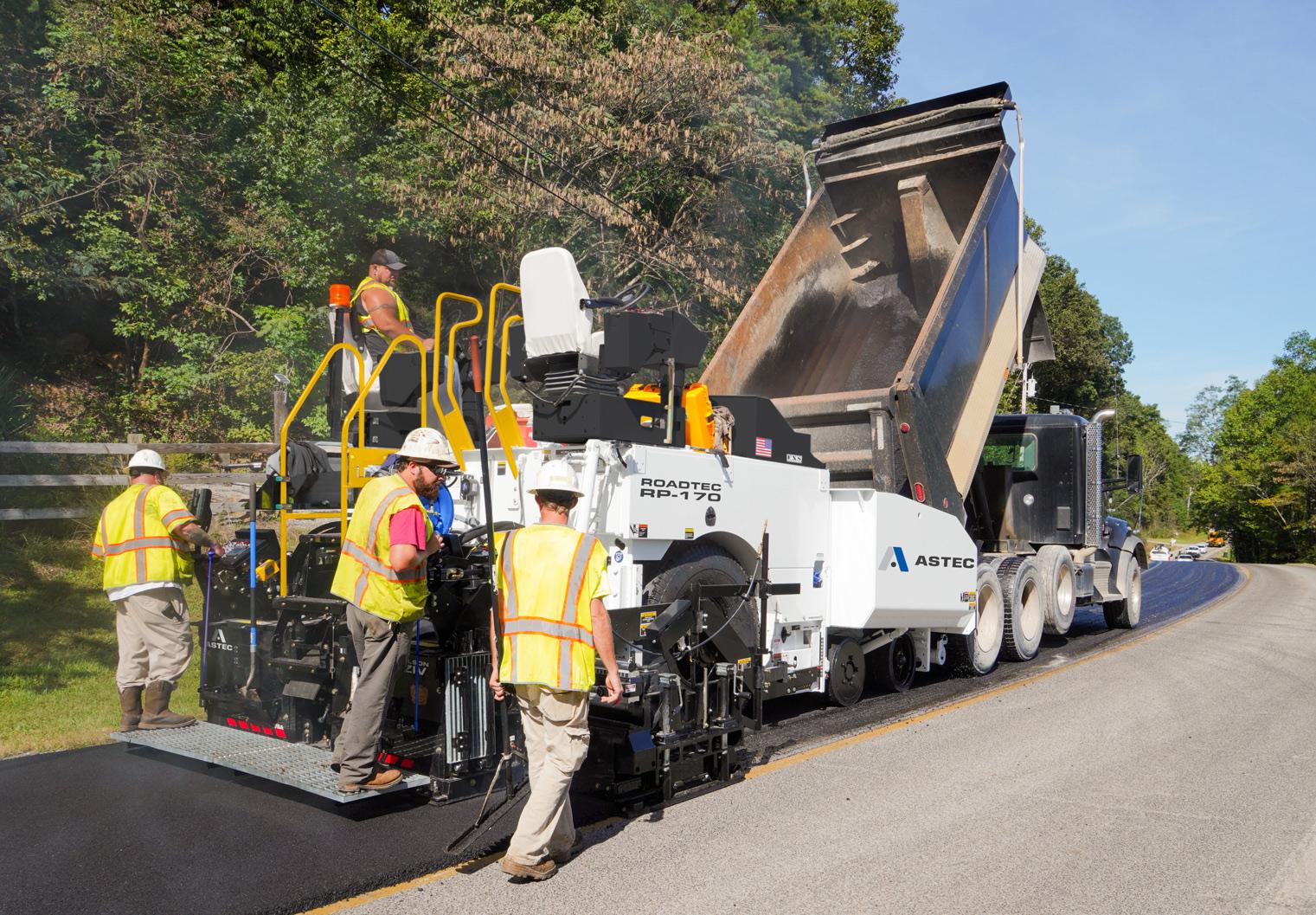Forging Ahead
Contracting Crews Will Be Busy With Phases of $500M Project
Contractors for the Georgia Dept. of Transportation (GDOT) — including ER Snell — have started to continue construction activities related to the I-16/I-75 Interchange Improvement Project in Macon-Bibb County.

After C.W. Matthews completed Phase 1 of the $500 proj-

ect, which covered the area of I-16 from the I-16/ I-75 split to the Martin Luther King Jr. Boulevard exit, crews from E.R. Snell now are executing Phases 2 and 3, which cover the area of I-75 from Hardeman Avenue to I-16 eastbound.

Work for this portion of the project includes:

• Continue construction of Riverside Bridge approaches, roadway and pipe installation;

• Continue construction of the Walnut Street bridge over I-75;
$1.3B Upgrade Calls for Georgia Power to Bury Electric Lines

Georgia Power is planning to bury electric lines in several Buckhead neighborhoods in 2023 as part of a $1.3 billion plan to improve its systems and reduce blackouts in the Atlanta area.
First, the electric utility needs to secure the necessary easements by winning over property owners in the path of the project, Buckhead.com, a neighborhood news service, reported Jan. 6.
Situated within the northernmost part of
Atlanta, Buckhead is a commercial and residential district of the city that is home to high-rise office buildings, hotels, shopping centers, restaurants and condominiums centered around the intersection of Peachtree Road and Piedmont Road. It also includes a total of 43 leafy neighborhoods.
Buckhead’s impressive urban forest is a huge civic asset, but also means that storms — like the remnant of Hurricane Irma in 2017 — often topple trees into power lines.
Burying — or “undergrounding” — the lines is a way to avoid that problem.
“Placing power lines underground makes the grid more resilient because they’re less vulnerable to storms and wind, but it’s not fault-proof,” said Georgia Power spokesperson Marie Bertot. “In areas prone to flooding, digging, root vegetation and other underground activity, it’s not always an option.”
Undergrounding also is done for aesthetic
reasons as well, but the Georgia Power work in Buckhead will leave existing poles standing to carry lines from the street to houses and businesses, and for use by telecommunications companies. According to one source, additional poles may be erected to deal with the new web of connections.
Buckhead.com noted that the underground system also requires a series of transformers housed in familiar green metal
GEORGIA STATE EDITION A Supplement to: Your
1-800-409-1479 ® “The Nation’s
February 22 2023 Vol. XXV • No. 4 see GDOT page 8 see POWER page 2 CALL 800-367-4937 *On approved credit Financing Available SHIP WITHIN 48 HOURS SAME DAY PARTS AVAILABILITY 24 HOUR TECHNICAL SUPPORT BACKED BY A 75 YEAR BUSINESS State Supplement sponsored by: Affordable Price. Premium Service. Thousands in Service!
Construction crews from E.R. Snell have ramped up construction activities with the next phases of the $500 million I-16/I-75 Interchange Improvement Project in MaconBibb County.
Georgia Connection: Rich Olivier, Atlanta, GA •
Best Read Construction Newspaper… Founded in 1957.”
Georgia Power to Bury Electric Lines in Buckhead Neighborhood
POWER from page 1
boxes to be installed in front yards and along sidewalks. That means many residents in north Atlanta will be hearing from Georgia Power contractors about buying easements for those transformers.
The utility dig will take place along both the Paces Ferry and Powers Ferry road corridors in the neighborhoods of Chastain Park, Paces, and Tuxedo Park, in addition to part of North Buckhead between Ivy and Wieuca roads.
Georgia Power aims to begin construction this spring and summer, with the work lasting approximately 12 months.
Upgrading Georgia PowerÊs Electric Grid
The project is just one part of Georgia Power’s “Grid Investment Plan,” a major, multiyear project of systemwide improvements. The goals are to improve the reliability of Georgia’s electric grid and lessen the impact of any failures. The company is about two years into the first phase.
Bertot assured Buckhead.com that the improvements to the Georgia Power system are not performed randomly.
“We are making strategic grid investments, selecting project locations based on historical service and performance data to
ensure that we are putting our resources in the right places to improve reliability,” she said.
The grid has two basic components: transmission, where power is sent over long distances to localities; and distribution, which is delivering electricity into home and businesses.
On the transmission side, the plan includes replacing wires and/or structures, and substation improvements up to full reconstruction. As far as distribution, undergrounding is just one of several improvement tactics.
Others include:
•Adding “automated line devices” that isolate outages to smaller parts of the grid.
• Adding connections, which can provide a backup power source.
• Relocating lines in hard-to-reach areas so that repairs are easier to make.
• Performing line strengthening, which can refer to a variety of upgrades in localized spots that make damage or other failures less likely.
Buckhead is in line to get automated line devices and strengthened poles, according to Georgia Power. Many other neighborhoods, such as Druid Hills, will receive similar improvements, including undergrounding.
Method Designed to Cause ÂMinimal DisruptionÊ to Public
The undergrounding method requires various metal boxes be set into the ground to provide power switching and delivery. A “single phase transformer” box must be placed “every few homes” for delivery, according to Georgia Power’s website. The green boxes on a concrete pad are 26 in. high, 34 in. long and 31 in. wide and need about 10 ft. of clearance on each side.
They are installed in the public right of way, which in residential areas typically means a narrow strip of lawn along a roadway. Contractors are now contacting residents seeking easements to install the devices, offering around $1,000 as compensation.
Georgia Power noted that the easements are all voluntary, though it is unclear what happens if property owners refuse, especially on an entire street. The company’s answer is that in such cases it would “explore other project alternatives,” Buckhead.com said.
The utility company explained that it aims for “minimal disruption” in installing such devices, but cautioned the work might require trimming trees, removing landscaping and digging up sidewalks. Georgia Power added it would pay to replace damaged landscaping and sidewalks.
The undergrounding affects only the main distribution line, not the lines going to individual properties, so poles will remain for that purpose. Georgia Power said it notified telecommunications companies that may also use the poles about the work but cannot control whether they choose to bury their lines.
Any pole used purely for carrying a Georgia Power distribution line would be removed after the undergrounding.
Undergrounding Plans
Following are the general areas and timelines for the undergrounding of lines in Buckhead, according to Georgia Power. All the general areas include “most side streets in the area,” the utility said.
• Powers Ferry Road corridor between Lafayette Avenue and Blackland Road, with a projected start in the spring.
• The North Buckhead area between Wiecua Road, Ivy Road and Ivy Chase. That work should also begin this spring.
• Work in the Paces area around West Paces Ferry Road and Northside Drive is slated to start this summer.
• More utility excavation is planned along the Paces Ferry Road corridor between River Forest Road and Howell Mill Road/Downwood Circle.
GTB Approves Unique, Temporary Plan for Talmadge Bridge
A unique proposal to replace the cables of the Talmadge Memorial Bridge, thus raising it so that taller shipping vessels can access the Port of Savannah, Ga., got a greenlight from the Georgia Transportation Board on Jan. 26.
Capitol Beat, a news service in Atlanta, noted that the plan can be done without closing the bridge to traffic at an estimated cost of $150 million to $175 million.
Andrew Hoenig, construction program manager of the Georgia Department of Transportation (GDOT) Office of Alternative Delivery, told a Board of Transportation committee that since the bridge’s construction in the late 1980s, “There have been a lot of upgrades in cable technology, and you also have [over 30] years of wear and tear and degradation on the cables.”
While many bridge projects across the nation have involved replacing cables or creating more draft space for ships to pass underneath, the approved process combining the two tasks in the same project is a “unique approach,” Hoenig said to Capitol Beat.
The project is the first of its kind approved
by the transportation board, which allows GDOT greater flexibility when it comes to designing and building with contractors, the Savannah Morning News reported.
The new process, called Construction Manager/General Contractor (CM/GC), allows the agency to consider alternative contracting methods with an approved contractor during the entirety of a project, including the design and risk mitigation phases, according to a GDOT spokesperson.
So, instead of merely replacing the cables, the CM/GC method can look at modern technologies, design complexities and consider greater creativity in addressing existing problems, while perfecting the construction timeline.
The contracting method received approval from the Georgia Legislature two
years ago and will allow GDOT to work directly with cable bridge industry experts to seek solutions and implement muchneeded maintenance on the 32year-old bridge, the Savannah news outlet noted.
Pre-construction bids will go out at the end of 2023, with a more concrete timeline of design and construction to come next year, GDOT said.
Longer-Term Solutions Sought for Bridge
When the Morning News asked the Georgia Ports Authority about plans for the proposed bridge work, it directed all questions to GDOT, citing the lack of a long-term solution.
The state’s approach does not replace the multi-year study GDOT is conducting to find a more permanent plan to allow for larger vessels to pass under the state-line crossing, which includes replacing the bridge, moving its location, or raising the foundations of the existing bridge.
“At the current 185-ft. clearance, the bridge limits efficient access for larger ships, which need to travel under the bridge to reach the Port of Savannah,” according to a

statement from GDOT. “The challenge will be magnified in the coming decades as larger ships become increasingly common because of their fuel efficiency and lower overall operating costs.”
Savannah Mayor Van Johnson said he was not sure what this maintenance solution would entail, but he hopes GDOT will be mindful of the Talmadge Bridge’s proximity to downtown Savannah and several of its neighborhoods.
“It appears that they found a solution that utilizes existing assets and new technology,” he told the Morning News. “And, preliminarily, it looks like this could be a win-win. It wouldn’t close the bridge for a significant period of time, and it wouldn’t change the configuration of the city’s assets on the southside of the bridge, so we’re waiting to see how the rest of it plays out.”
The Talmadge Bridge crosses the Savannah River and connects the city to Hutchinson Island, Ga. It also carries U.S. Highway 17, which moves traffic through the area into South Carolina. The span first opened in 1991 and replaced a 1950s-era cantilevered truss bridge. The towers that hold the cable-stayed bridge deck are positioned on either side of the river’s main shipping channel.
Page 2 • February 22, 2023 • www.constructionequipmentguide.com • Georgia State Supplement • Construction Equipment Guide



Construction Equipment Guide • Georgia State Supplement • www.constructionequipmentguide.com • February 22, 2023 • Page 3
Asian Company Investing $2.5B to Expand Georgia Factories
A South Korean solar panel maker is investing more than $2.5 billion to build factories in Georgia, hiring 2,500 new employees and making components usually manufactured outside the United States, the company announced in January.
Qcells, a unit of Hanwha Solutions, will build a new factory in Cartersville, Ga., planned to employ 2,000 people, with construction getting under way soon, and production starting before the end of 2024.
WAGA-TV in Atlanta reported in January that the company also announced a third phase to its Dalton, Ga., plant, already the largest maker of solar panels in the Western Hemisphere. Qcells will add another 500 jobs in that northwestern Georgia city, raising employment at the factory above 1,500 once all expansions are complete.
“We are seeking to further expand our low-carbon solar investments as we lead the industry towards fully American-made clean energy solutions,” Qcells CEO Justin Lee said in a statement.
The new factory in Cartersville, in Bartow County, south of Dalton, will assemble solar panels, silicon ingots and wafers, and solar cells. Qcells plans to use polysilicon made at an REC Silicon plant in Washington State following Hanwha’s purchase of 21 percent of REC shares in 2022.
Qcells now makes solar modules capable of generating 1.7 gigawatts of electricity each year at the Dalton plant, WAGA-TV noted. Following the facility expansions, the company will make 8.4 gigawatts worth of modules, or about 10,000 solar panels. That will include a capacity of 5.1 gigawatts in Dalton and 3.3 gigawatts in Cartersville, the manufacturer said.
The company has 750 people working at its existing Dalton factory, and Qcells announced plans last year for a second $171 million phase, hiring 470 more workers.
State, Federal Officials Welcome Expansions
Politicians from both sides of the aisle in the Peach State celebrated the announcement, with Gov. Brian Kemp touting Qcells’ plans as an example of Georgia setting itself apart as “the No. 1 state for business.”
“Combined with our robust logistics infrastructure, top-ranked workforce training program, and collaborative approach, Georgia provides a business-friendly environment that means jobs for hardworking Georgians in every corner of the state and success for both existing and new companies,” he said.
President Joe Biden described the news as “a win for workers, consumers and our cli-
mate,” in a statement, adding that it would provide good jobs, reduce American reliance on other countries for solar components, lower the cost of solar panels and help lower carbon emissions.
Once operational, the Cartersville plant will fulfill one of the aims of the climate change and health care bill that Biden signed last August. It included provisions from Georgia Sens. Jon Ossoff and Raphael Warnock allowing companies making the components used in solar panels to claim tax credits.
“My goal remains to make Georgia the world leader in advanced energy production,” Ossoff said in a statement.
Warnock, Ossoff and Biden administration officials say Biden’s strategy is working to enhance the nation’s manufacturing base as part of the transition to clean energy.
“By 2027, the Qcells expansion is projected to supply about 30 percent of total U.S. demand for solar panels,” John Podesta, the president’s clean energy adviser, told reporters. “I think it’s fair to say that this deal is President Biden’s vision come to life.”
The White House said the administration’s policy has driven $300 billion in private investment by industries including semiconductors, clean energy, electric vehi-
cles and batteries, with nearly $25 billion of that coming in Georgia.
That includes two $5 billion-plus electric vehicle plants, and a $4 billion-plus battery plant announced for Cartersville in December, WAGA-TV reported. Hyundai Motor Group is building one of the vehicle plants and is partnering with fellow South Korean firm SK Group to build the Bartow County battery factory.
The Atlanta news outlet noted that Georgia economic development officials have particularly promoted electric vehicles and batteries.
“Qcells has long been a pioneer in the solar industry, and it solidified Georgia’s place as a leader in renewable energy and sustainable technology when it cut the ribbon on the largest solar panel manufacturing facility in the Western Hemisphere in 2019,” Georgia Economic Development Commissioner Pat Wilson said in a statement.
The total incentive package from state and local governments was not immediately clear, but Qcells could qualify for more than $65 million in Georgia income tax credits, at $5,250 per job over five years, if workers make at least $31,300 a year. Local officials have said Qcells workers in Dalton have starting wages of $17 an hour.
Work On GMC’s Center for Leadership Completes This Spring
Construction efforts are continuing at the NewDay USA Center for Leadership at Georgia Military College (GMC) in Milledgeville, Ga. The project was originally slated for completion by the end of this year, but the prep school, to make the facility as innovative as possible, has been making changes to the blueprints.
The school now hopes to have the project open in the spring.
“The real delay up to now has been us,” GMC President Lt. Gen. William B. Caldwell IV told the Union-Recorder. “We’ve continually upgraded the interior from what was originally designed. What was looking more like a high school performing arts venue has now blossomed into what I would now call a state-of-the-art center that can host not just performing arts, like Broadway-type shows, but also nationally recognized speakers.”
The 29,000-sq.-ft. building joins several other GMC campus facilities in the town of Milledgeville, located northeast of Macon in Baldwin County.
Augusta-based builder RW Allen Construction and its subcontractors are working on both the exterior and interior of the future 820-seat facility, the Milledgeville Union-Recorder reported Oct. 16.
Meanwhile, GMC itself is performing the landscape design.
“We want this facility to literally transform that block in terms of its beauty,” added Caldwell.
He said the Center for Leadership construction currently is tracking for a March 2023 finish. That would leave plenty of time to open the curtain in late April for GMC’s
spring musical, where high school students will perform “Swing: The Musical” as their seasonal show.
“Mark Weaver [GMC’s fine arts director] and his team did a wonderful job looking for something representative of America to open it up,” Caldwell said.
New Facility to Host Series of Guest Speakers
In addition to being a fine arts performance center for its students, the new building will double as a hall where prominent guests can engage with GMC’s college and prep school cadets through a leadership speaker series. Recognized individuals from the military, business and political realms will be welcomed onto campus and share their insights and experiences with students.
Former United States presidents have even been discussed as possible guest speakers, according to GMC officials.
“It will be nationally-renowned names that will be coming here, which we believe will draw an audience in from well outside of Milledgeville,” noted GMC Foundation Executive Director Mark Strom.
No speakers have yet been tabbed, but GMC leaders told the Milledgeville news source that the first high-profile guest will
likely speak on the campus next fall.
The school also looks forward to hosting professional theater shows inside the venue. GMC sees it as a possible economic driver for the community as it may bring theater fans to Milledgeville to dine and lodge while in town to enjoy a performance.
VA Mortgage Lender Pays for Naming Rights
The NewDay USA Center for Leadership is a partnership between the local military college/prep school and NewDay USA, the respected Veterans Affairs mortgage lender, headquartered in Fulton, Md.
The lender has had a relationship with GMC going back to 2016, and paid $10 million for the naming rights, noted the Milledgeville news outlet. Last year, the Union-Recorder reported that the overall construction cost at that time was estimated to be $13 million.
Through NewDay’s foundation, the company has provided full scholarships to more than 30 GMC Prep students whose parents died or suffered a disability in military service to America. NewDay also gives scholarships to students whose parents have served and been impacted by the Global War on Terror.
Page 4 • February 22, 2023 • www.constructionequipmentguide.com • Georgia State Supplement • Construction Equipment Guide
“We want this facility to literally transform that block in terms of its beauty.”
Lt. Gen. William B. Caldwell IV Georgia Military College



































































































































Construction Equipment Guide • Georgia State Supplement • www.constructionequipmentguide.com • February 22, 2023 • Page 5 M FOR R AD ® CAT educes drag on the tip and adapt RODUC P & NCE A TIP DVANSYSTM I V I T & ADAPTER SYYSTEM Y F n components me I AT L L TA INS l AD FR DAPTER REE nd n a RS WEL $1 $1 /h D RATE 35 E r ADVA WHEN ANSYS VER ON U C YO T A BOU S A K U *AS T TO H S W FFER L O DDITIONA PROMO CODE: ESERVIC DVA R A FO ROM T F VER ON OU C N Y E ADAPTER VE ON S C NSY -SERIES M K RSION Offer valid through 6/3 LEARN MORE A V | Contact Us Today Cat “Modern Hex” trade dress as well as and © 2023 Caterpillar. All Rights Reserved. CAT 30/23 while supplies last. See we AT YanceyBros.com/ada 800-2 Call: | YanceyBros.com Visit: s corporate and product identity used herein, are trademarks of Ca T, CATERPILLAR, LET’S DO THE WORK, their respective logos, “C A bsite for additional details or call pter 82-1562 terpillar and may not be used without permission. aterpillar Corporate Yellow”, the “Power Edge” us.
Construction Takes Off to Extend Runway 5 at Macon Airport
A long-awaited project in Macon, Ga., took off Jan. 24 when local, regional and state officials attended a groundbreaking ceremony at the Middle Georgia Regional Airport (MCN) to extend the facility’s Runway 5/23.
“This extension will provide so much opportunity for the growth at our airport and will make it more convenient for our current tenants,” said Macon Mayor Lester Miller. “This is a project that has been in the works for many years, and we are thrilled that it is finally happening.”
Also in attendance were Macon-Bibb County leaders, airport staff, airport tenants and many other community partners. They all got to see the beginning of a necessary project that has been under discussion for 40 years and follows more than a decade of arduous behind-the-scenes efforts to make it happen.
“The runway extension is important for a variety of reasons, such as improving safety for large aircraft operations, and allowing for larger aircraft to land and take off at MCN with full payloads,” explained Doug Faour, aviation director of Macon-Bibb County. “It also makes the airport more attractive for commercial airline service to other destinations and increases air-service charter opportunities to other destinations.”
Initial Construction On New Retaining Wall
The first phase of the project will be the construction of a retaining wall near the approach end of Runway 5, which is in the southwest corner of the airport property near Sardis Church Road. Atlanta-based Precision 2000 is building the wall for $2.2 million, paid for by federal infrastructure funds and other grants.
An added $168,000 in grant funds will pay for Passero Associates, a national engineering firm with an office in Atlanta, to supervise that contract.
The Georgia Department of Transportation’s (GDOT) highway division is also contributing funds to the first phase of work at MCN.
“The Middle Georgia Regional Airport will be better suited to compete for business, and we will be successful,” said Faour. “We’ll be successful because of our proximity to the world’s busiest airport [Hartsfield-Jackson Atlanta International], our proximity to Robins Air Force Base, and our location in the center of the state.”
The actual extension of the runway and the installation of an Engineered Materials Arresting System (EMAS) is set to occur during the second phase of construction. According to the Federal Aviation Administration (FAA), EMAS uses crushable material placed at the end of a runway to stop an airplane that overruns the runway. When the aircraft’s tires sink into the lightweight EMAS material, it decelerates the plane and brings it to a halt.
Passero Aided in RunwayÊs Approval, Lower Cost
The county had been trying for years to secure justification for a runway extension. During that time, local officials met with three airport consultants before contacting Passero in March 2020 for help in obtaining FAA and GDOT approval of the runway expansion. The justification study was submitted that summer to both agencies and approved by GDOT and the FAA in the early fall.
The planning and technical report was completed promptly, according to Passero, and its high-quality product helped to quickly obtain approval, enabling MCN to move the project forward.
Passero demonstrated that a 600-ft. extension was needed for the airport, which would increase the length of Runway 5/23 from 6,500 ft. to 7,100 ft. Based upon the engineering firm’s reports, GDOT gave the greenlight to a total length at Macon’s airport between 7,100 ft. to 7,300-ft.

In re-evaluating the extension alternatives requested by the FAA, based on the justified length of 7,100 ft. for the expanded runway, Passero’s planning team was able to help reduce the estimated construction costs from $40 million to the $12-14 million range by using EMAS, and Declared Distances, the specific lengths of runways published for pilots to understand their allowable take-off and landing weights and speeds.
The extension should be completed in late 2024 or early 2025.
Additional Upgrades Coming to Macon Airport
Plans also are in the works for a new air traffic control tower as Macon is one of 30 cities approved by the FAA for new construction, Faour told WMAZ-TV in Macon.
In October, the county commission approved spending nearly a quarter-million dollars for a conceptual design and environmental site study for a new corporate terminal building at the regional airport.
The plans call for constructing a two-story, 15,000-sq.-ft. building for offices, conference rooms, spaces for gatherings, and a restaurant, all at a cost estimated to be in the range
of $6 million to $9 million, according to the contract. Passero is drawing plans and doing 3D modeling for the new terminal for the fixed-base operators (FBOs), which consist of businesses granted permission to work on airport grounds to provide necessary services such as fueling, maintenance, or other aviation-related services.
In addition, the engineering and architectural company last year began studying the feasibility of moving existing corporate hangars to another location on the more than 1,000-acre MCN property.
In November 2021, Macon-Bibb County initially hired Passero for a period of five years as a consulting architect and engineer of record to lead the renovation and expansion efforts at the airport, which included conducting a competitive bid process to select a construction company to rehabilitate the airport’s Taxiway C. Shortly thereafter, Reeves Construction Co., based in Duncan, S.C., was awarded the contract.
Luring cargo carriers back to Macon also is part of the plan. FedEx used to fly out of MCN until about 10 years ago, Faour told WMAZ-TV.
The new corporate terminal will be a crucial step to boosting the airport’s reputation as it will offer the first impression of the community to company executives and other highprofile visitors flying in on private jets.
In 2020, Macon-Bibb County approved work on the airport’s secondary runway,
will be used as the main landing
Page 6 • February 22, 2023 • www.constructionequipmentguide.com • Georgia State Supplement • Construction Equipment Guide
which
strip during the extension project.
Map courtesy of Passero Associates
The first phase of the project will be construction of a retaining wall near the approach end of Runway 5, which is in the southwest corner of the airport property near Sardis Church Road. The actual extension of the runway and the installation of an Engineered Materials Arresting System (EMAS) is set to occur during the second phase of construction.

Construction Equipment Guide • Georgia State Supplement • www.constructionequipmentguide.com • February 22, 2023 • Page 7
Crews Move On to Next Phase of GDOT’s I-16/I-75 Project
GDOT from page 1
• Continue demolition and removal of the existing I-16 westbound and I-75 northbound and southbound bridges;
• Construction of MSE (retaining) walls along I-75 northbound and southbound and at other locations throughout the project continues;
• Construction of concrete sound and visual walls along I-75 northbound and southbound continues;



• Continue demolition of the existing pavement on the left lanes of I-75 northbound from Hardeman Avenue to north of the Riverside Bridge; and
• Continue concrete paving for new I-75 northbound and southbound roadways, and new I-75 southbound ramp to new I-16 eastbound.
Crews began the newest phases of construction on Feb. 10.
Phases 4, 5: From I-16 WB/I-75 to Walnut Creek

Work for these phases consists of:
• Continue construction of bridge substructures for I-16 Spring Street entrance and exit ramps;
• Continue construction of new Second Street bridge substructure;
• Continue construction of one new I-16 westbound bridge substructure and two superstructures;
• Continue construction of two new I-16 eastbound bridge substructures;
• Pouring bridge deck spans and edge beams on new I-16 eastbound bridge superstructure;
• Continue construction of two new I-16 westbound entrance ramps;
• Continue demolition of bridge ramp to I16 eastbound;
• Continue construction of new MSE (retaining) walls along I-75 northbound and southbound and other walls throughout the project; and
• Installing pipe and other drainage structures throughout the project area.
Constracting crews and members from GDOT currently are evaluating project area for remaining work items of Phase 1.
Overall, the I-16/I-75 Interchange Improvement project will enhance safety and mobility of the interchange by widening and reconstructing I-75 from Hardeman Avenue to Pierce Avenue and I-16 from I-75 to Walnut Creek within the city of Macon and Macon-Bibb County. This project represents a $500 million investment in the city, the Middle Georgia region and the state’s transportation system and will support Georgia’s growing freight and logistics industry.
More specficially, the project aims to construct additional interstate lanes, wider shoulder lanes and additional on- and offramps. A new collector/distributor (CD) road system will be constructed parallel to both I16 and I-75, which will allow additional noninterstate traffic capacity. Modifications will be made to bridges and surface streets within the project area to accommodate the additional interstate and CD lanes. These surface street improvements will add or expand dedicated turn lanes, which will reduce congestion and improve mobility for commuter traffic.
Phases Complete
Phase 1: I-16 Eastbound — Improved approximately 1.5 mi. of I-16 EB between I75 and Coliseum Drive. Phase 1 construction contract was awarded to C.W. Matthews, low bid at $70 million.
This portion was completed in summer 2022. Roadwork included operational improvements to I-16 WB at the Spring Street interchange. These improvements eliminated the existing weave and improve safety on I-16 EB between I-75 and Spring Street. Crews also closed the Spring Street loop ramp and constructed the I-16 EB collector distributor (CD) road between I-75 and Spring Street.
Pleasant Hill Community
Phase 1B — Involved the mitigation improvements to the Pleasant Hill Neighborhood on each side of the I-75 corridor. The Phase 1B construction contract was awarded to E.R. Snell for $13 million.
This portion of the project was completed in spring 2018. Roadwork included the relocation and rehabilitation of home to seven vacant lots and building 17 new residential structures throughout the community; created a linear park that includes green space and multi-use trail, lighting and information kiosks along the east side of I-75; created the Jefferson Long Park on the west side of I-75; the boyhood home of Little Richard, the Penniman House, was relocated adjacent to the Jefferson Long Park and serves as a community resource center, where specially created mobile interpretative panels are now displayed; constructed noise and visual walls along I-75 within Pleasant Hill; replaced the David Lucas Pedestrian bridge, transformed an existing open drainage ditch into a grasscovered culvert and streetscaping (resurfacing and sidewalk rehabilitation) throughout the community; and the closure of Frontage Road between First and Second Streets to be
Page 8 • February 22, 2023 • www.constructionequipmentguide.com • Georgia State Supplement • Construction Equipment Guide
used as greenspace access to pedestrian bridge.
(All photos courtesy of Georgia Department of Transportation.)
Crews also will continue demolition and removal of the existing I-16 westbound and I-75 northbound and southbound bridges; building of MSE (retaining) walls along I-75 northbound and southbound and at other locations throughout the project; and construction of concrete sound and visual walls along I-75 northbound and southbound.
Phase 1: I-16 Eastbound was completed last summer by C.W. Matthews.
Phases 2 and 3 cover the area of I-75 from Hardeman Avenue to I-16 eastbound.
Phases 4 and 5 cover an area from I-16 WB/I-75 to Walnut Creek.

Construction Equipment Guide • Georgia State Supplement • www.constructionequipmentguide.com • February 22, 2023 • Page 9



















Page 10 • February 22, 2023 • www.constructionequipmentguide.com • Georgia State Supplement • Construction Equipment Guide Shipping and Handling Included WE PURCHASE COLLECTIONS!!! Visit our Ebay Store – bmckeon collectibles – for a complete list with pictures. Toys For Boys (and also men) Realistic Scale Models of Construction Equipment, ideal gifts for the Holidays, Birthdays, Graduation, etc. Caterpillar AP-1000 Asphalt Paver, 1:50 scale - $100 Case 1085B Cruz-Air Backhoe, 1:35 scale - $85 Manitou MT337 Telehandler w/bucket, 1:25 scale - $95 Caterpillar 345B, Series II Material Handler, 1:50 scale - $90 Caterpillar D6K XL Track-Type Tractor, 1:50 scale - $75 Gooseneck XL120 Low-Profile HDG Trailer, 1:50 scale - $85 Caterpillar 428C Backhoe/Loader, 1:50 scale - $75 Two Michigan L320 Wheel Loaders, 1:50 scale - $80 Caterpillar 12G Motor Grader, 1:50 scale - $75 Caterpillar 320C L Excavator, 1:50 scale - $65 John Deere 872D Motor Grader, 1:50 scale - $60 Caterpillar 936 Wheel Loader, 1:50 scale - $75 John Deere 320 Skid Steer Loader, 1:32 scale - $50 Euclid Quarry Truck, 1:50 scale - $55 Caterpillar 725 Articulated Dump Truck, 1:50 scale - $65 Case 330 Articulated Dump Truck, 1:50 scale - $50 Contact – Barry McKeon 610-506-5961 Email – bmckeon9@gmail.com Bmckeon Collectibles 470 Maryland Drive Fort Washington, PA 19034
Connected to Customers, from Rock to Road®
We help build the roads that connect goods to markets, people to communities and families to one other. Astec pavers, screeds, mills, stabilizers and MTVs yield innovative and reliable Rock to Road solutions that create value and connection. We are inspired to connect with our customers through innovative design for safe and reliable roads. astecindustries.com

Construction Equipment Guide • Georgia State Supplement • www.constructionequipmentguide.com • February 22, 2023 • Page 11 COWIN.COM | 18002392694 Birmingham, AL 205.841.6666 Montgomery, AL 334.262.6642 Mobile, AL 251.633-4020 Oxford, AL 256.832.5053 Pensacola, FL 850.479.3004 Huntsville, AL 256.536.9390 Tuscaloosa, AL 205.848.4147 Atlanta, GA 404.696.7210
ROCK TO ROAD® Lawrenceville, GA COMING SOON

Page 12 • February 22, 2023 • www.constructionequipmentguide.com • Georgia State Supplement • Construction Equipment Guide




















































































